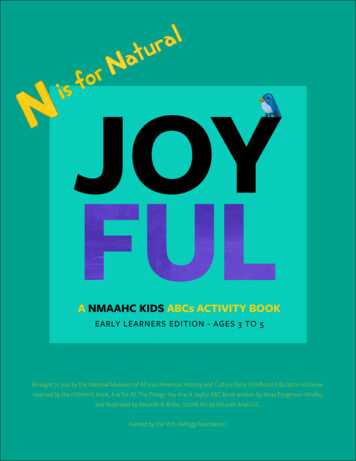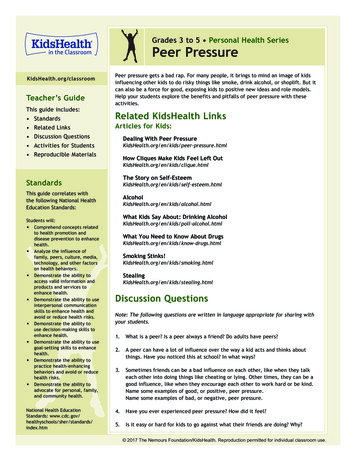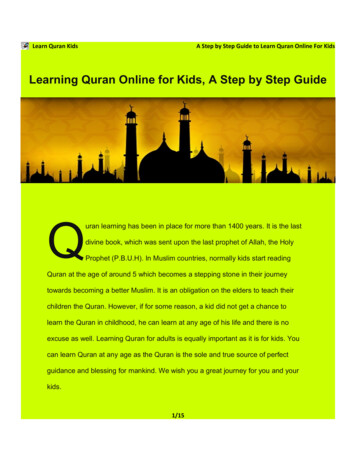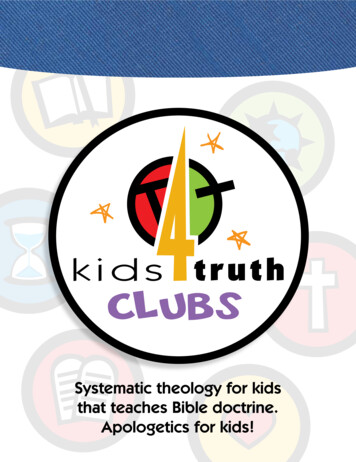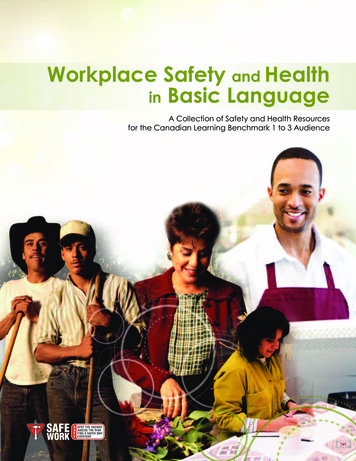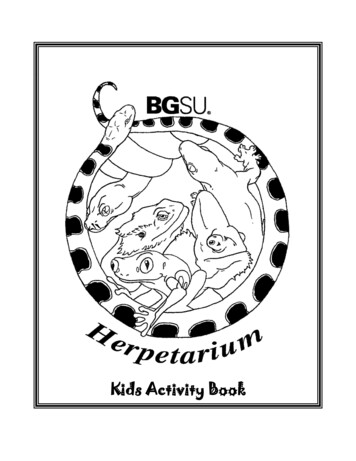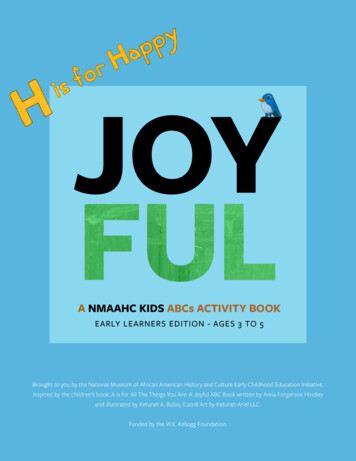
Transcription
A NMAAHC KIDS ABCs ACTIVITY BOOKEARLY LEARNERS EDITION - AGES 3 TO 5Brought to you by the National Museum of African American History and Culture Early Childhood Education Initiative.Inspired by the children’s book, A is for All The Things You Are: A Joyful ABC Book written by Anna Forgerson Hindleyand illustrated by Keturah A. Bobo, 2018 Art by Keturah Ariel LLC.Funded by the W.K. Kellogg Foundation.
A is for All the Things You Are was written to affirm ourchildren and empower them to see themselves as many things at once – daringand loving, creative and just, amazing and zany – and everything in between.The book offers wonderful opportunities for conversations with children tobuild their vocabularies, strengthen their sense of self and deepen their joyin and acceptance of human diversity. The illustrations allow them to see notonly themselves but others in the same positive light as well. By seeing positiveimages of children of different colors, genders, abilities, classes, and other socialidentities, we nurture the child’s comfort and joy in human diversity so deepcaring connections can be made across humanity. In exploring ideas such asfairness, kindness, open-mindedness and being vocal, children begin the task ofrecognizing injustice and knowing how to stand up for themselves and others.Each activity booklet offers suggestions of how to begin the lifelong work ofhaving a positive sense of self and others with your early learner, how to supporttheir language development and how to build the foundations of literacy.A Is for All the Things You Are: A Joyful ABC Book 2018 Art by Keturah Ariel LLC (artwork) 2018 Smithsonian Institution (text)1
H is for Happy:There are wonderful things right in front of you.Hold a friend’s hand. Stop to smell a flower. You’ll be happy!How can you share your happiness with others?We all want our children to be happy but we often mistake excitementfor happiness. Laughter and big smiles are contagious and satisfyingbut they are only one way that children show their happiness. Hugs,snuggling and relaxing into another person’s presence are signs ofhappiness. Being absorbed in a self-directed, focused task is also a formof happiness. Though these kinds of happy moments are often taken forgranted, we can support our children to notice and name these calmertimes as happiness.l ABC BookA Is for All the Things You Are: A Joyfuork) 2018 Art by Keturah Ariel LLC (artw 2018 Smithsonian Institution (text)As you support your child in acknowledging the many ways we can experience happiness, we can also introduce (orremind them) of simple experiences that spark happiness like time in nature and time with friends.Children can feel engaged and happy when we invite them to play and explore outside and in nature. Whether it’s in apark, countryside or along a city street, trees, fresh air, birds and flowers can help us all breathe deeper, move slowerand notice more. Like nature, relationships are essential to our health and happiness. When we encourage our childrenin making friends and maintaining friendships, we are building their capacities for thriving in our world.As we slow down to encourage our little ones to discover the many ways happiness is possible they become ourteachers, showing us how to live in the moment and to continually find new ways to be aware and connected. It is thataware connection that makes happiness possible for us all.WhatYou’ll Need:The following supplies are suggested for the experiences in this booklet. Tip:PaperChalkScissorsCrayons, markers or colored pencils1-2 Cardboard tubesPackaging or masking tapeBinoculars (optional)Natural materials (like flowers and leaves)Beanbag, small stones or a sock filled with dry riceBuild an at-home creativity kit full of all the supplies and recycled materialsyou’ll need for future ABC art and play activities. Find the supplies list here!2
EXPLOREIn early childhood, children learn best through doing!Explore this week’s theme with your child by trying thisengaging experience inspired by our museum collection.Discover Happinessinthe Sounds andSightsofNatureWhat You’ll Need Paper Crayons, markers or colored pencils Binoculars (optional)Right outside our doors, there’s a whole world of plants, animals and happiness to discover. When we slow down, lookand listen to all the things around us, we can find something that makes our hearts feel happy. Sometimes a flower’s colormay make us smile! Jumping in a puddle can feel exciting! Watching leaves falling can make us feel peaceful. There aremany ways nature brings happiness to people.This week find happiness in taking a closer look at the different birds living all around you. Take a bird watching walkoutside and use some or all of the suggestions below.Stop! Go outside. Slow down and listen carefully. What can you hear?Look! Can you see any birds? Some birds may be on the ground, flying or perched in a tree.Tip: Take a closer look at birds with binoculars! Use a store-bought pair or make yourown by taping together two cardboard tubes.Listen! Can you hear any birds? Notice the different sounds they make.Use Your Words. Use words to describe the birds’ colors, moves and parts you can see. If youknow the kind of bird it is, say its name out loud.Draw. Bring along paper and something to draw with. Then, draw a picture inspired by the bird.3
CREATECreate art inspired by this week’s theme!Createa Nature FriendshipBraceletWhat You’ll Need 1-2 Cardboard tubes Packaging or masking tape Scissors Natural materials (like flowers and leaves)Building friendships with peers is one of the great joys of childhood! Having a friend a child can play, talk and sharewith gives them a true sense of happiness. Combine the joys of nature and friendship by inviting your child to create a naturefriendship bracelet to give to a good friend. Start by talking to your child about the big and little friends in their life: How do youlike to play with your friends? What makes your friends special? How does being with your friends make you feel?Choose one friend (or a few!) to make a friendship bracelet for and follow the steps below.Grown-Ups1. Cut a toilet paper tube in half to make two small tubes. They’ll become abracelet for your child and a bracelet for their friend.2. Cut the rolls up the side. This allows the tube to become a cuff-like bracelet.3. Apply tape to the outside of the cuff so that the sticky side is facing outward.EarlyLearners1. Take a nature walk with a grown-up to collect small leaves and flowers todecorate your bracelets. Look for interesting colors, shapes and textures.What items would make your friend happy?2. As you gather the natural materials, add them to the sticky side of thefriendship bracelets.3. Once your bracelets are covered, choose one to give to your friend. Let themknow how happy they make you feel!4
LEARNInvite your child to take part in the following experiences tosupport their literacy and language skills.HappyHopscotcheedNWhat You’ll riceChalkfilled with drycksoaroseall stonBeanbag, smPlay inspires happiness! Whether indoors or outdoors,alone or with friends, play is a joyful experience for childrenand it comes in many forms. This week, invite your child toplay outside and with a friend to boost their literacy.Start by drawing a hopscotch-like grid on the sidewalk with chalk. If your little one wants to help, invite them to draw asimple row of squares or other shapes.Next, together with your child, spell out their name by writing a single letter into each square. Later, think about addingnew letters! (Draw as many squares as you need.) Once the letters and the squares are complete, try this: Say a letter or make a letter sound out loud. Invite your child to jump, hop or step to that letter and counthow many hops it takes you to get there. Invite a friend to play. Together and side by side, children can hop on one foot or two onto each letter. As theygo, they may sing a song or come up with rhyming words together! Encourage your child to toss a stone or beanbag onto a letter. When they stop, you can all call out theletter and think of words that start with the letter together. 5
EXPLORE MOREContinue learning with your little one using these recommended resources:BooksAs you enjoy a book from the list below, talk to your little one about what brings them happiness. How is their happinesssparked similarly or differently than the characters in the stories?You Are My HappyLayla’s Happinessby Mariahadessa Ekere Tallie,by Hoda Kotb,illustrated by Ashleigh Corrinillustrated by Suzie MasonMy Heart Fills With HappinessNowby Monique Gray Smith,by Antoinette Portisillustrated by Julie FlettTip:Use your favorite search engine to find read-aloud videos online!Online ResourcesSing a joyful song and do a happy dance with the videos below!Happy by Pharrell WilliamsThe Happy Happiness Song - Sesame StreetElmo’s Happy Dance - Sesame Street6
CONNECTA Guide for Families and CaregiversWhy do these experiences matter?A child’s identity is both internally constructed and externally imposed. They learn who they are and how they are valued from the wordsand actions of others and from the way they do or don’t make sense of those messages. Their beloved adults (that’s you!) are the mostimportant people in their world. The words you give a child to describe themselves and others have lasting power in their lives. When achild has the words to think about their strengths and their worth, they can sort through negative messages and hold on to their senseof being loveable and capable. The experiences in this booklet are invitations for you to use objects, activities and words to support yourchild’s positive identity development, their fascination with how people are both different and the same, and their ability to read emotionsand build empathy. In time, experiences like these will also support your child’s ability to recognize unfairness or unkindness and to standup for themselves and others.What about supporting language development and getting ready to read?Alphabets, in and of themselves, are not particularly interesting to young children. However, learning letter-filled words to describe theworld around them and inside of them (their feelings, experiences and senses) are very interesting to children! Discovering new words, newways to say things and new ways to think is exciting and essential to a child’s literacy and identity development.The developmental path to reading is a child’s understanding that, “Anything I do or see, I can say! Anything I say can be written! Anythingwritten can be read!” Many booklet experiences will encourage you to engage in conversations about objects and during story times todeepen your child’s connection to spoken and written words. Other experiences will invite you to build literacy skills by writing down whatyour child says, feels or thinks and reading it back to them aloud. Some booklets will introduce fun ways to boost fine motor skills thatcontribute to a child’s writing and reading abilities. The booklets will also recommend books that intrigue children by illustrating the richdiversity of people in the world and providing them with a mirror to their own lives or a window into other lives.Every child’s path to literacy is different and valid - just like their identity. The experiences in these booklets aim to support you and yourchild along their unique journey to literacy and a positive sense of self. Remember to have fun along the way!CreditsObjects Untitled (Round Bird on Wood) by Clementine Hunter, ca. 1965. Collection of the Smithsonian National Museum of African American Historyand Culture, Gift from the Collection of Sabra Brown Martin, Cane River Art Corporation. 2017.68.1Program Photos Doug Sanford, National Museum of African American History and Culture, 2019Original Artwork Bluebird (cover, page 3); Flowers and trees (pages 2-6), 2018 Art by Keturah Ariel LLC7
As you enjoy a book from the list below, talk to your little one about what brings them happiness. How is their happiness sparked similarly or differently than the characters in the stories? My Heart Fills With Happiness by Monique Gray Smith, illustrated by Julie Flett Layla’s Happiness
